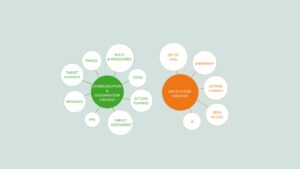“Dissemination and exploitation is an obligation and opportunity for a project to further scale-up the results, shed light on the work done and bring value to it by creating a positive impact in various fields”, as mentioned in the section 14 of the Horizon Europe Programme Guide.
Why is it important?
As early as at the proposal stage, applicants must submit a first draft of the Plan for the dissemination and exploitation including communication activities (PDEC), as part of the Impact section.
However, applicants often underestimate the importance of this section, focusing their efforts on the scientific and technical parts of the proposal (which are very important indeed!). This is without realising that a large part of the evaluation is based on the suitability and quality of the actions to disseminate and exploit the project’s key outputs, maximise outcomes in the medium term and impact in the long term.
Another issue, mainly related with exploitation, is that often applicants consider that it is too early to identify results and their exploitation routes during the proposal preparation phase. This is something they would rather prefer to focus on once (and if) the project is selected for funding.
It is to be noted that the rules for participation under Horizon Europe reinforce focus on exploitation, as well as the role of the PDEC during and after the end of the project. So, if applicants are not familiar with these aspects, as it is often the case, we recommend including in the consortium a partner specialised in communication, dissemination, and exploitation. It will be a real added value in drafting this section, and an important partner if the project is funded!
What are the evaluators expecting?
So, what are evaluators expecting to see in your preliminary dissemination and exploitation plan?
Don’t get caught unprepared! Below are the main points you need to include in the first draft of the PDEC of your Horizon Europe proposal:
- Describe what is the aim of your communication and dissemination activities and define your main messages;
- Identify your target groups. For each identified category, try to mention specific groups of stakeholders, associations and networks that will have an interest in your activities and results: this will show evaluators that you concretely know who you will reach out during the project implementation.
- Describe communication and dissemination tools and channels to reach out to your target audience, including a precise timeline. In addition to obvious tools such as a website and social media channels, consider innovative tools (MOOCs, podcasts, etc.)
- Set precise Key Performance Indicators (KPIs) for dissemination and communication so that impact of the different activities can be easily measured and monitored;
- Describe your exploitation strategy: Identify Key Exploitable Results (KER), their ownership status, the sector of application, protection measures and a timeline for their exploitation. Don’t forget to define the strategy for the management of Intellectual Property.

Figure: Key elements of a good PDEC
If you are not familiar with these concepts, check our article about the difference between communication and dissemination.
My proposal has been selected for funding! What’s next?
If the proposal is successful, beneficiaries must provide the complete PDEC, which is a deliverable due for submission by month 6 after your project starts and which must be regularly updated. These updates are the opportunity for beneficiaries to report on the activities undertaken, to monitor if KPIs are reached and if not, to plan mitigation actions.
Where to start? It is good practice to start with the preliminary dissemination and exploitation plan that you have included in your project proposal, and further develop it with the help of partners. You should now be more specific and really develop a comprehensive plan that will guide your consortium through the communication, dissemination and exploitation activities and rules that will need to take place throughout the project. You will have to make sure each partner is committed to increasing the impact of the project and thus it is a good practice to assign precise responsibilities for each activity.
Several tools (monitoring table, dissemination rules) can be implemented to meet the EC expectations and to assess the impact of communication & dissemination activities and the follow-up of KPIs. These are all the more essential in the context of Horizon Europe, as each activity must now be entered one by one in the EU portal as part of the continuous reporting (find our tips for the continuous reporting here).
What happens after the end of the project?
There is more: in the last version of your PDEC (to be submitted at the end of the project), you’ll have to make sure that you have concrete plans to exploit your results, whether commercially or non-commercially, even after the end of the project! The obligation to devote best efforts to the exploitation of results is applicable four years after the end of the action. If results have not been exploited one year after the end of the project, it is mandatory to publish exploitable results in the Horizon Results Platform to grant visibility and facilitate third party exploitation.
For more information on how to draft your Plan for the exploitation and dissemination of results, you can read the Horizon Europe Standard Application Form and the dedicated section of the Programme Guide.
If you are looking for support to draft the Impact section of your proposal and/or for an expert partner to lead the Work Package on communication and dissemination, you can reach out to contact@euronovia.eu!
